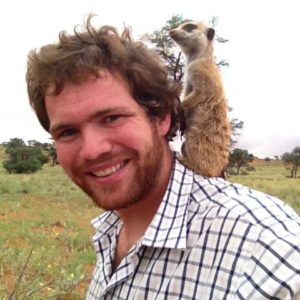I’m back in England now after a successful season in the Kalahari. I spent nearly four months out there in the end on this trip, and managed to sample 125 of the meerkats. I was really pleased with getting this number as that represented a good percentage of the population at present, and included members of all groups. The purpose of the sampling season was to get familiarity with the groups, get an idea of how well the tests worked, and get some background information on the population before starting any interventions.
The field season gave me an excellent opportunity to really get an understanding of working with the meerkats, but also how the project works, and even a chance to meet some of the Friends! I visited 19 groups and learned a lot about the animals’ individual personalities – including Sachin’s habit of using the nearest human as a lookout post if I sat too close to a bush! There are lots of different research exercises going on at the KMP, and so working out who was doing what with which meerkats was a good use of time. The dynamic nature of the groups was something that I possibly wouldn’t have fully appreciated beforehand and was something that I will need to factor into my study design. A splinter group broke away from Friks’ Army whilst I was a the site and formed Ghostbusters; the establishment of this group was great to watch.
Tuberculosis work is hampered by diagnostic limitations and so working on new tests and checking on the performance of those available to us now is an important element of my whole PhD. I took blood samples from all the meerkats that I worked with. I have used these to both look for anbtibodies to TB with a new test kit developed for cattle, and also to attempt to identify markers of infection in the blood at a stage before antibodies are detectable. The latter work is ongoing and is being done in collaboration with Stellenbosch University near Cape Town. It will be very exciting if this works out as it will offer much more scope for monitoring the population. Interpreting the antibody results is going to take some time as the test has previously only been used on cattle so I can’t report these back yet. I’ll be using the results of other tests and future knowledge of what happens with these individual meerkats to calibrate the test. I’ve taken fluid samples from the tracheas of all the meerkats that I could sample, and these are currently being cultured in Stellenbosch to look for signs of active disease.
As all of the tests that I have used are either in development or being processed at the moment, I cannot give you much information on the levels of infection in the KMP population at the moment. The good news for the meerkats was that there was not much active disease over the time that I was there. Mr. Jackie was euthanased due to the disease in December, and then Boo in March – both at Pandora. Boo in particular was sad, as I had had time to see his lump developing and had seen him on a number of occasions. As I was leaving the first signs of disease were beginning in Mayans, and Catalonia was euthanised shortly after my departure. These losses are currently low compared to other years, but show that the disease is still very much alive in the population. Clinical samples form all three of these animals have been submitted for culture, and if we can grow any TB (actually quite difficult) then the bacteria will be submitted for genetic analysis. We hope that these three meerkats will be able to contribute to our understanding of the disease.
I am now working back in the UK to get various permissions for the next stage of the project. I have obtained ethical permission for the work from the University of Pretoria and have already got approval for the work carried out so far from the Royal Veterinary College, London. I’m using these to support a current application to the Department of Agriculture in South Africa to allow me to carry out the work. Other than that, my current work is based around preparing a protocol for the field. I’m in contact with both Prof. Tim Clutton-Brock and postdoc Dr. Ben Dantzer at Cambridge to work out which groups are going to be most appropriate to work with and how to go about the work. I intend to begin vaccinating pups later this year.



